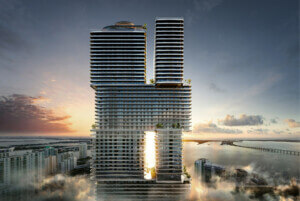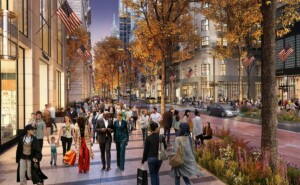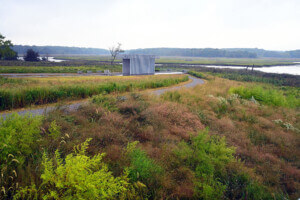This story is part of a monthlong series of guests posts by AIA New York that feature Archtober Building of the Day tours. See the full 2017 schedule here.
On Sunday, Archtober toured Freshkills Park, a former New York City landfill on Staten Island redeveloped into a 2,200-acre green space. Our tour guide was Mariel Villeré, the Manager for Programs, Arts and Grants at Freshkills Park. She gave us insights into the park’s history, design, and construction.
An NYC Parks minibus picked us up from the Staten Island Ferry Terminal for the 30-minute ride to the site. After signing our waivers and traveling some distance over sanitation department roads, we arrived at the Visitor Center. Here, Villeré delved into the history of the site and the project.
Until the mid-20th century, Freshkills Park was a wetland. In 1948, Robert Moses chose this supposedly “useless” site to create a landfill, which by 1955 was the largest in the world. The waste was dumped into four huge mounds, North, South, East and West, which today form the basis of the park’s landscape. The waste dump, which all five boroughs used, was officially ordered to close in 1996, and the last barge of refuse was sent to Freshkills after the World Trade Center attack in 2001. (The boroughs now have separate contracts with outside landfills; Staten Island’s garbage, for example, is shipped to South Carolina).
In 2001, the Freshkills Park Alliance and NYC Parks launched a competition for a site masterplan, which James Corner Field Operations won. Their plan proposed the four distinct areas of the park based on the garbage mounds, along with a central area, known as the Confluence. Our tour focused on North Park, which recreates and strengthens the site’s wetlands and creeks. The entire site is two-and-a-half times the size of Central Park.
In North Park, we took in the stunning views over Staten Island to Manhattan on the north and the rest of Freshkills Park to the south. Villeré discussed the vision behind the park’s design, noting how they needed to balance the recreation of the former habitat with the understanding that the site’s ecology and meaning have been irrevocably changed by 50 years of trash. While the garbage is under several layers of topsoil, no attempt is made to downplay the typical mound shape of the landfill. This creates an ecological opportunity in the northeast, where the drive for reforestation sometimes sidelines open spaces and wetlands. The diversity of the park has increased dramatically over the last few years, with over 100 species of birds now counted at the site.
Villeré outlined the manifold challenges of creating a park on top of a landfill. Landfills generate two byproducts: landfill gas and leachate. At Freshkills, landfill gas is funneled into treatment facilities where its components, methane and CO2, are separated. The methane is piped into the New York City gas grid. The other product, leachate, is the liquid that forms, on a small scale, at the bottom of a trash bag. At Freshkills, permeable pipes laid in concrete ditches at the bottom of each mound collect the leachate. It is then treated and separated into leachate cakes, a highly concentrated substance, and clean water. We also drove by a flare station, which is a backup in case there is an issue with the system piping methane into the grid.
Since the site is so huge, the project is necessarily phased. These phases are arranged from the outside in order to give back to the surrounding community, which was negatively impacted by the dump. The timeline has therefore prioritized small, demonstrable projects along the park’s edges. So far, some wetland restoration, Owl Hollow soccer fields, the New Springville Greenway, and the renovation of Schmul Park have been completed. We got a view of Schmul Park in the Travis neighborhood just to the west of the park.
The redesign of a Moses-era blacktop playground–also by James Corner Field Operations–is now vibrantly colorful, packed with children and families on the warm October day. It is a blueprint for the success of an extraordinary project that will transform not only an extraordinary site, but how we think about the relationship between waste and nature in New York and beyond.










